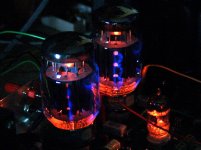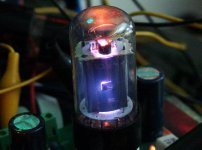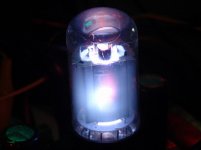I have had my SSE up and running for a few weeks, and just got around to hooking up the UL and CFB switches. I have been turning the amp off before switching but may have gotten impatient and not let the amp cool enough (probably less than a minute) before switching and it made a painful noise.
How long should I be waiting before I switch modes? I have been doing A/B testing and have built a set of Madisound BK-16's to go with and have been tweaking a lot and don't want to break anything.
Finally, the amp sounds great (all compliments go to George for a great sounding, easy to build beginner project) but I have one concern being new to tubes. I am running Tung-Sol 6550 tubes and one is quite gassy looking, there is a blue haze the covers most of the inside of one of the tubes, the other only has a few small spots. Is this anything to worry about?
Thanks.
How long should I be waiting before I switch modes? I have been doing A/B testing and have built a set of Madisound BK-16's to go with and have been tweaking a lot and don't want to break anything.
Finally, the amp sounds great (all compliments go to George for a great sounding, easy to build beginner project) but I have one concern being new to tubes. I am running Tung-Sol 6550 tubes and one is quite gassy looking, there is a blue haze the covers most of the inside of one of the tubes, the other only has a few small spots. Is this anything to worry about?
Thanks.
If you can't hear music anymore, you should not get the *pop*. That said, you can use a meter to find out how long your B+ stays up.
As for the blue glow, that depends on what it looks like. Are those the reissue Tung-Sols? Mine did not have any blue glow, save for maybe a few small spots. If the glow is on the glass, it's usually OK. If the glow seems to be around the electrodes, that is usually not a good sign. One of my Tung-Sols shorted and blew-up the cathode resistor in my SSE.
As for the blue glow, that depends on what it looks like. Are those the reissue Tung-Sols? Mine did not have any blue glow, save for maybe a few small spots. If the glow is on the glass, it's usually OK. If the glow seems to be around the electrodes, that is usually not a good sign. One of my Tung-Sols shorted and blew-up the cathode resistor in my SSE.
Last edited:
I have some strange things happening with my UL tap then, the music had completely faded, but there must have been enough stray voltage to get sound to the speakers. I have a motor-run cap and I forgot to put a bleeder resistor on it.
The other day I started the amp cold in UL without CFB and that created a constant whistle or whine. I shut it down and turned on CFB and UL together and powered it back up and all was well.
I'm not that worried, unless advised that I should be; the amp sounds great, far better than I had expected. The UL mode is the only thing that has produced odd noises, but it is fine once warm, no hum whatsoever.
Thanks for the info on the tubes. They are indeed the reissue 6550's. The glow is on the glass, the tube in question looks a lot like those in your avatar image, the other only has a few of the blue spots. Given your experience it may be worth a call to TCT where I bought them.
The other day I started the amp cold in UL without CFB and that created a constant whistle or whine. I shut it down and turned on CFB and UL together and powered it back up and all was well.
I'm not that worried, unless advised that I should be; the amp sounds great, far better than I had expected. The UL mode is the only thing that has produced odd noises, but it is fine once warm, no hum whatsoever.
Thanks for the info on the tubes. They are indeed the reissue 6550's. The glow is on the glass, the tube in question looks a lot like those in your avatar image, the other only has a few of the blue spots. Given your experience it may be worth a call to TCT where I bought them.
That sounds normal. The pop may still be heard for a while after the music has faded.
As to the whine, it almost sounds like you are actually running with CFB off and when you flipped the switch it turned the feedback on. If you got the phasing of the feedback backwards (see George's instructions), you'll get positive feedback. That turns the amp into an oscillator. You'll get squeaks, whistles, etc. Try running in triode mode and leave the CFB switch alone. Double-check your wiring. I'm not sure what switches you used, but most toggle switches are "backwards". That is, the handle is opposite of the contact that is closed.
The tubes in my avatar are SED KT88s, which are well-known to have blue glow on the glass. Inconsistencies like yours between tubes of the same construction sometimes indicate an alignment issue. But if the tube works OK, it might be fine. They just don't make 'em like they used to.
As to the whine, it almost sounds like you are actually running with CFB off and when you flipped the switch it turned the feedback on. If you got the phasing of the feedback backwards (see George's instructions), you'll get positive feedback. That turns the amp into an oscillator. You'll get squeaks, whistles, etc. Try running in triode mode and leave the CFB switch alone. Double-check your wiring. I'm not sure what switches you used, but most toggle switches are "backwards". That is, the handle is opposite of the contact that is closed.
The tubes in my avatar are SED KT88s, which are well-known to have blue glow on the glass. Inconsistencies like yours between tubes of the same construction sometimes indicate an alignment issue. But if the tube works OK, it might be fine. They just don't make 'em like they used to.
If you got the phasing of the feedback backwards (see George's instructions), you'll get positive feedback.
If the amp gets louder when the CFB is turned on you have it backwards. This will increase the distortion, cause instability and make a very loud power oscillator with EL34's.
Blue glow ON THE GLASS is not a problem at all. It will eventually fade as the tube wears.
Blue glow inside the tube where vacuum should be and around the internal elements is a sign of internal contamination. Back in the 60's it was a reason to replace the tube. New production tubes do not have as pure a vacuum as many old tubes, so a snall amound of blue or purple glow inside between the grids and the plate may be acceptable. This tends to increase as the tube wears until the glow takes over the vacuum and the tube (and some circuitry) dies! As Russ stated, usually the cathode resistor and cap.
The first picture shows a normal pair of KT88's. After 4 years this glow is gone, but they still work fine.
The second picture shows a seriously defective 6V6GT. It was NOS, but from a clearly defective batch since about half were bad. It was already sounding nasty when I turned it on, but I decided to let it run for a while. The third picture shows the same tube after running for an hour at max power. It blew up shortly after that picture was taken.
Attachments
Thanks for the images George, I suppose I should have done the same. In any event, my blue tube looks like the healthy image not the latter two. Interesting the blue goes away over time, I would have guessed it to be the other way around. I have a lot to learn about this stuff though.
And Russ, I am using NKK switches and yes the handle does indeed point away from the closed contact. I will recheck the wiring but the amp is about the same volume whether running CFB or triode mode. (It is worth rechecking the wiring but the sound with CFB is really good, very clean it sounds like it knocks down some of the harmonic distortion.)
When I inadvertently powered the amp up (cold) with UL but not CFB I got the whine (due to the 'backward' switch issue Russ pointed out). I shut it down after a few seconds and the noise decayed very quickly. After the amp was good and warm (after running in triode for a solid hour or two) I shut it down and switched back to UL+CFB and all was good. I guess come to think of it I have never tried to run the amp in UL mode only.
Switching to UL tap the amp is a lot louder but doesn't sound quite as clean to me, a very subtle bit of 'edge' for lack of better term, great for rock though. I'm really happy with the amp, but my six-year-old son insists on making the music selections... and he likes my wife's music. Parenting is all about sacrifices.
And Russ, I am using NKK switches and yes the handle does indeed point away from the closed contact. I will recheck the wiring but the amp is about the same volume whether running CFB or triode mode. (It is worth rechecking the wiring but the sound with CFB is really good, very clean it sounds like it knocks down some of the harmonic distortion.)
When I inadvertently powered the amp up (cold) with UL but not CFB I got the whine (due to the 'backward' switch issue Russ pointed out). I shut it down after a few seconds and the noise decayed very quickly. After the amp was good and warm (after running in triode for a solid hour or two) I shut it down and switched back to UL+CFB and all was good. I guess come to think of it I have never tried to run the amp in UL mode only.
Switching to UL tap the amp is a lot louder but doesn't sound quite as clean to me, a very subtle bit of 'edge' for lack of better term, great for rock though. I'm really happy with the amp, but my six-year-old son insists on making the music selections... and he likes my wife's music. Parenting is all about sacrifices.
Switching to UL tap the amp is a lot louder but doesn't sound quite as clean to me, a very subtle bit of 'edge' for lack of better term, great for rock though.
That is about the same as my observations. I usually use UL with CFB for loud rock, and triode without CFB for the mellow stuff.
There should be no strange noises other than a small thump at turn on or turn off in any mode. Try turning the volume all the way down before power up or power down, to see if it makes a difference. It could be an interaction with your source.
Reading this brings up a question in my head: If people's observations (and preferences) - and they match my experiments with UL/CFB - are what they are: Why would one want to have two individual switches for UL and CFB instead of just one that does UL/FB or Triode/NoFB?
Is it just availability of 4 pole/2 position switches or are there situations where the ability to individually switch stuff has advantages?
Just curious about your thoughts, since I have recently disabled the switches and deferred the UL/CFB decision until I have time to move the amp into its final enclosure.
Cheers,
Stefan
Is it just availability of 4 pole/2 position switches or are there situations where the ability to individually switch stuff has advantages?
Just curious about your thoughts, since I have recently disabled the switches and deferred the UL/CFB decision until I have time to move the amp into its final enclosure.
Cheers,
Stefan
Yes...DPDT switches are far more common, especially when aesthetics are taking into account. There is also the issue of having all of B+ on one side of the 250VAC switch and a few 10s of volts on the other, depending on the design of the switch. The contacts themselves are only dealing with a few tens of volts for both cases, but one set is dealing with them at a much higher, overall potential.
UL / UL+CFB
dagerman, I have been putting some hours into listening. I like SE mode for acoustic and jazz (very musical, esp through horns)
I go with either CFB or CFB+UL for electric stuff (rock, indie, electronic, etc). I actually like how CFB tightens up the sound on busier music and listen like this probably 50% of the time; it seems like a good balance to me. It is nice to have options available.
As for the switches, I went to the opposite extreme and have each channel individually wired for CFB and UL (i.e., four NKK switches), that helped me keep the wire salad organized. They are all lined up behind the tubes but in front of the OPT's so are not obtrusive. I owe the community pictures of the rig, it turned out pretty well IMHO.
dagerman, I have been putting some hours into listening. I like SE mode for acoustic and jazz (very musical, esp through horns)
I go with either CFB or CFB+UL for electric stuff (rock, indie, electronic, etc). I actually like how CFB tightens up the sound on busier music and listen like this probably 50% of the time; it seems like a good balance to me. It is nice to have options available.
As for the switches, I went to the opposite extreme and have each channel individually wired for CFB and UL (i.e., four NKK switches), that helped me keep the wire salad organized. They are all lined up behind the tubes but in front of the OPT's so are not obtrusive. I owe the community pictures of the rig, it turned out pretty well IMHO.
- Status
- This old topic is closed. If you want to reopen this topic, contact a moderator using the "Report Post" button.
- Home
- More Vendors...
- Tubelab
- UL CFB Switching - Beginner Question


